- Offensive Techniques & Strategies
Off Ball Defense/Ballside Denials
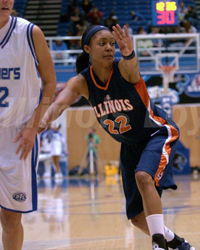
On defense, like with offense, the majority of the time is spent guarding players without the ball or “Off Ball.” Yet, most coaches and players spend little time or effort in learning and refining their off ball defensive skills. Off Ball defensive efforts should be focused on obtaining the basketball, not just protecting the basket.
Players need to understand that defense starts prior to their opponent receiving the ball not after. Off Ball fundamentals are the building blocks of a strong team defense. Off Ball defensive fundamentals require that players become highly skilled and proficient in first pass denials, disrupting cutters, providing strong backside support, and executing quick close outs.
| Pass Denial | Playing Up | Dancing | Staying Home | Pass Deflections |
| In Review | Drills for Skills |

Strong First Pass Denials
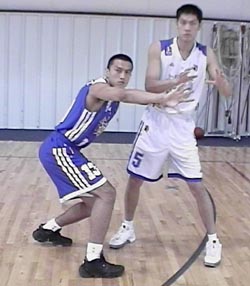
What to Discover or Recall:
Off Ball defenders must constantly attack the passing lanes.
Attacking the passing lanes disrupts offensive spacing and timing. It, also, forces the offensive players away from the basket increasing their shot and drive distance.
In assuming a pass denial position, the defender must play “UP” the passing lane between their opponent and the ball.
Attacking the Passing Lanes
Off ball defensive efforts should be focused on obtaining the basketball, not just protecting the basket. Therefore, to achieve this, Off Ball defenders must constantly attack the passing lanes. They must be alert and anticipate all passes. They must watch the passer's eyes since almost all passers will telegraph their passes. In attacking the passing lanes, defenders should deflect most passes rather than trying to catch them.
For first pass denials to be successful, defenders do not have to deflect or get a hand on every pass. By constantly attacking the passing lanes, it will disrupt offensive spacing and timing by forcing the offensive players further away from the basket in order to receive the ball. This increases, not only the opponent's shot distance, but also the drive distance to the basket adding an extra dribble, and increases the pass distance into the low post creating a greater opportunity for interceptions.
Basic Stance
"Ear on Chest"
Stay low maintaining a bent knee, "Ear on Chest" position. Use split vision. See the opponent and the ball.
Arm Extended with Palm Out
Extend an arm straight out into passing lane with the palm to the passer. The off arm is held in a high, in a bent elbow position maintaining slight contact with opponent.
Up and Off the Passing Lane
Deny the passing lane by playing "UP" between opponent and the ball.
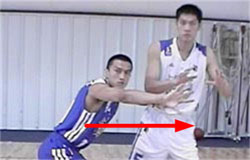

Pass Denial "Stop Sign"
Just by extending an arm straight out in the passing lane with the palm facing the passer ('Stop Sign'), in almost all cases, upon seeing a hand in the passer will immediately look for another receiver.
See the Ball on Defense
It is imperative to have vision on the ball at all times. Maintain vision on the ballhandler since most passers telegraph their passes. This is especially true in defensive transition.
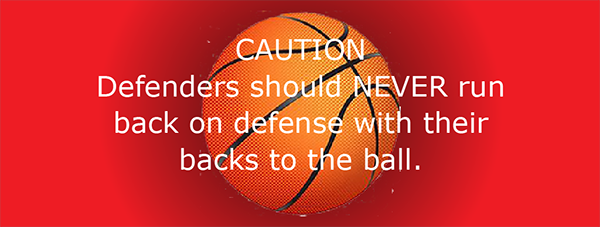

Playing Up (the Passing Lane)
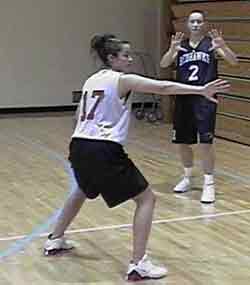
What to Discover or Recall:
Strong first pass denials require that the defender play up the passing lane.
To accomplish this, the defender must maintain a position, up the passing lane, between the ball handler their opponent.
All passes to the opponent should go through the defender.
Attacking and denying first pass passing lanes primarily requires a lot of effort and determination on the part of the defender. However, to be productive and successful, all of this energy and resolve needs to be combined with a working knowledge of the basic pass denial techniques.
Strong first pass denials require that the defender play up the passing lane. Any pass to the opponent should go through the defender. To accomplish this, the defender must assume a position, up the passing lane, between the ball handler and the person they are guarding at all times. The longer the passing lane, the further off (up the lane) the defender should play. The shorter the passing lane, the closer to the opponent the defender should play.
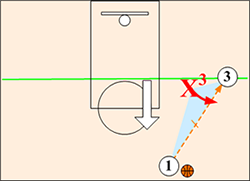
Ball - You - Opponent
Defenders should play up between their opponent and the ball at all times.
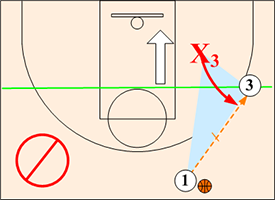
Incorrect
Ball - Opponent - You
From a DOWN position, there is a tendency to react and lunge at passes. This usually results in a near miss and/or getting beat on baseline dribble penetration.

Back Court Rule
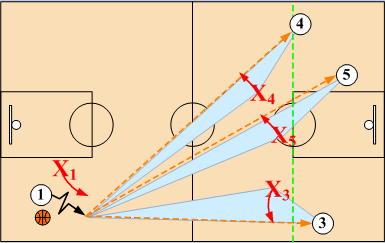
In defending against full court passes, all defenders should play above the free throw line extended until the ball crosses the mid court line. Take full advantage of the fact that most players are poorly skilled in making long passes.

Pass Distance Rule
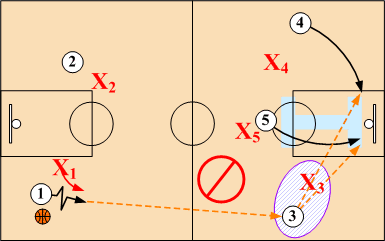
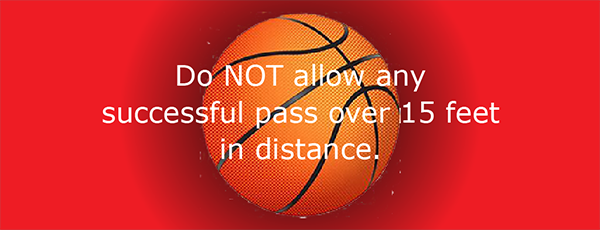
In allowing uncontested passes over 15 feet, it compromises the defense and opens up the entire court to the offense. It also forces all defenders to make major defensive adjustments and in the process makes them vulnerable to offensive attack.

"Dancing" with the Opponent
What to Discover or Recall:
Against back cuts, if at all possible the defender should try to maintain a shoulder to should pass denial position forcing the cutter toward the baseline pushpoint.
If the defender gets past the defender, the defender should just switch "Stop Signs" by extending the opposite arm and hand into the passing lane while making a quick head snap.
Maintaining a Strong Pass Denial
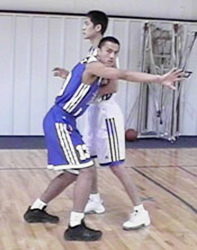
Preventing the opponent from receiving the ball, requires hard work and determination, however, strong pass denial only lasts three seconds. After three seconds the passer will have to find another receiver or risk a closely guarded five second count violation. Remember, the best way to defend an outstanding offensive player or "Super Star" is to deny them the ball.
When being over played, most offensive players will use head and shoulder fakes in an effort to get open. However, in most cases head and shoulder faking fakes out their own passer more times than it does the defender.
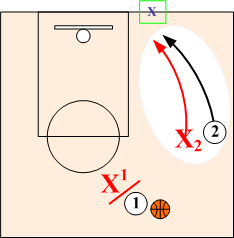
Defending Back Cuts
Against back cuts, if at all possible the defender should try to maintain a shoulder to should position, forcing the cutter toward the baseline pushpoint.
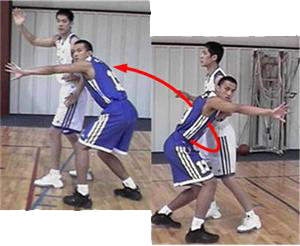
Switching "Stop" Signs
If the defender gets past the defender, the defender should just switch "Stop Signs" by extending the opposite arm and hand into the passing lane while making a quick head snap.
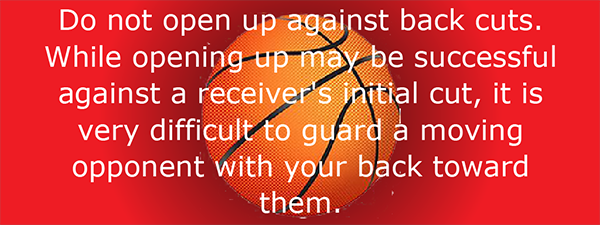
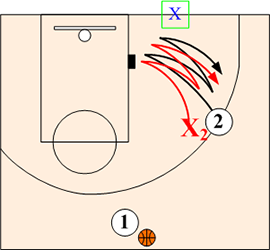
"Dancing"
If a player uses a series of head and shoulder fakes in an attempt to get open, the defender should just "Dance" with the receiver by switching stop signs.

Ballside Dribble Penetrations
What to Discover or Recall:
Do NOT leave shooters to help on dribble penetration.
Helpside defenders are responsible for rotating over to stop the ballhandler's penetration.
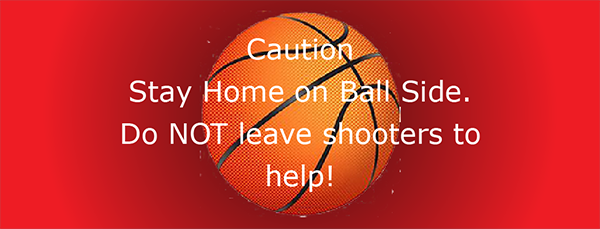
On dribble penetration, help comes from the Helpside not the ballside. Defenders on the ballside may bluff and fake at the dribbler, but their primary responsibility is to deny any kick out pass to spot up shooters.
Defending the Drive & Kick
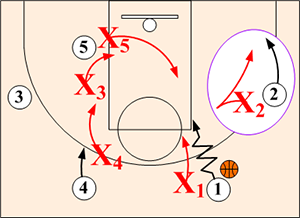
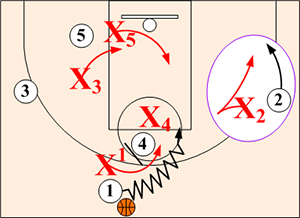
When a ballhandler penetrates to the basket on dribble, ball side defenders maintain strong pass denial positions and do NOT help.
Helpside defenders are responsible for rotating over to stop the ball handler's penetration. Low Helpside I defender steps out taking a charge whenever possible. Mid or high helpside defender drops to baseline.
Risks of Providing Help on Ball Side Dribble Penetration
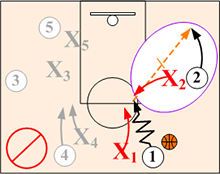
Open Spot Up
The problem of helping out on ball side is that smart point guards will penetrate to draw ball side defenders to them, creating wide open shots for shooters spotting up.
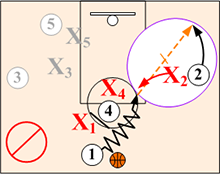
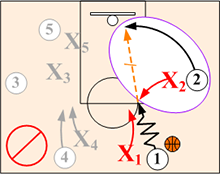
Lay-Up
If ball side defenders sag off to help out against dribble penetration, wing has the option of cutting to basket for an easy lay up.
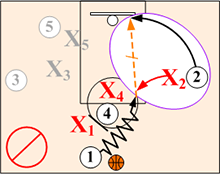
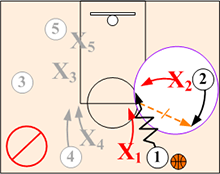
Kick Out Pass
When ball side defenders sag off to help against dribble penetration, it opens up the drive and kick option.
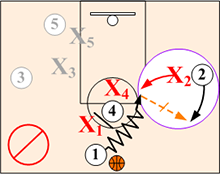
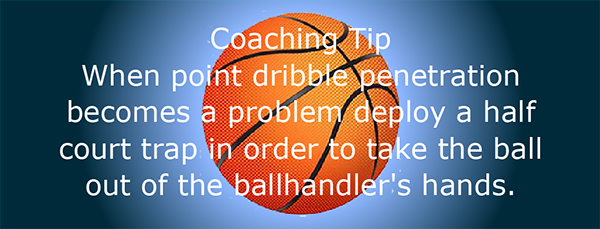

In Review
Off Ball defensive efforts should be focused on obtaining the basketball, not just protecting the basket. Players need to understand that defense starts prior to their opponent receiving the ball not after. Off Ball defenders must constantly attack the passing lanes. In constantly anticipating and attacking the passing lanes, it will disrupt offensive spacing and timing. In defending cutters, players must not only possess a working knowledge how to defend the basic cuts, but also need to develop an attitude and aptitude of anticipating and preventing them.
Preventing the opponent from receiving the ball, requires hard work and determination.
Attacking the passing lanes disrupts offensive spacing and timing. It also forces the offensive players away from the basket increasing their shot and drive distance.
The defender must maintain a low bent knee, “Ear on Chest” position with an arm extended out in the passing lane with the palm (Stop Sign) facing passer.
In assuming a pass denial position, the defender must play “UP” the passing lane between their opponent and the ball.
Defenders must have vision of the ball and their opponent at all times.
Players should never run back on defense with their backs to ball.
Ballside defenders never leave shooters to help against dribble penetration.
To insure possession when a pass is deflected, the defender must first cut off the receiver and then go for the ball.
On "Give & Go" basket cuts beat the cutter through on ball side.
The best way to defend an outstanding offensive player is to deny them the ball.

Drills for Skills
Like their offensive counterparts, individual defensive skills must be broken down, practiced and refined on all levels of the game.
Defensive Breakdown Drills - Click Here
Back to Player Defensive Skill Development - Click Here
Return to Player Development - Click Here
Return to Defensive Strategies - Click Here
Return to HoopTactics - Click Here
© 2026 HoopTactics All Rights Reserved.
